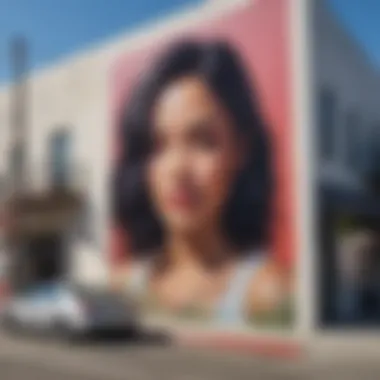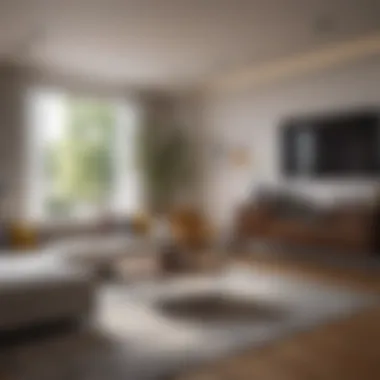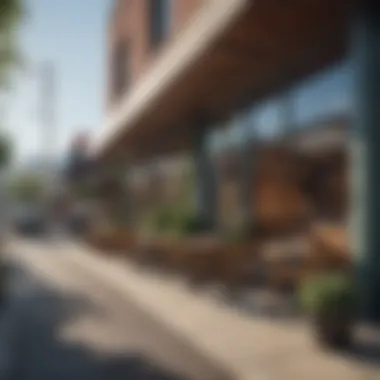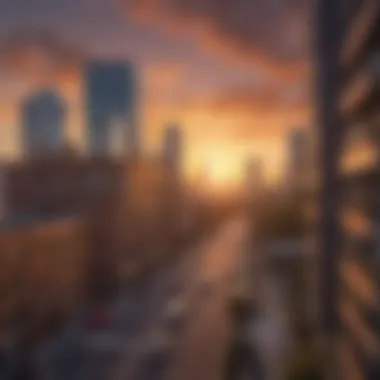Exploring the Arts District: A Guide to LA Apartments


Intro
The Arts District in Los Angeles is not just a neighborhood; it is a thriving cultural hub that attracts creatives from all over the world. As you explore this unique enclave, you will discover a plethora of apartment options that reflect the area’s artistic spirit and vibrant community. This guide aims to provide you with a comprehensive overview of what makes the Arts District so special, with an emphasis on the distinctive living spaces found here.
From stunning architectural designs to eclectic decor elements, each apartment tells a story, serving as both a home and a canvas for self-expression. Additionally, the Arts District is rich in cultural and historical significance, making it an ideal place for those seeking a dynamic lifestyle.
Potential residents will appreciate the insights provided in this article, which will cover key features that define the Arts District apartment scene, highlight must-visit neighborhoods, and explore the local art scene that influences daily life. Whether you are a real estate enthusiast, a travel lover, or an interior design aficionado, this guide will help you navigate the complexities of this artistic urban space.
Overview of the Arts District
The Arts District in Los Angeles stands as a distinct neighborhood, renowned for its vibrant character and unique living spaces. This section serves as a guide to comprehending the essence of this area, from its historical background to its cultural contributions. Knowing the history and context of the Arts District helps individuals appreciate the diverse community that resides here.
Historical Context
The roots of the Arts District extend back to the late 19th century, originally serving as an industrial hub. Factories, warehouses, and rail yards defined the landscape. Over time, these structures fell into disuse, leading to neglect. However, the late 20th century saw a transformation began. Artists recognized the potential of the abandoned spaces and started moving in, turning empty buildings into studios and galleries. This evolution laid the groundwork for a thriving artistic community. Today, the area is a mix of preserved historic buildings and modern developments.
Cultural Significance
Culturally, the Arts District is a melting pot of creativity. It has become a center for art enthusiasts, showcasing diverse styles and mediums. The presence of public art installations, murals, and galleries contributes to a unique atmosphere that encourages artistic expression. Events like art walks and open studio nights foster community engagement, allowing residents and visitors to connect through shared interests. This cultural landscape not only attracts artists but also those who appreciate the connection to art, making it a desirable location for individuals looking to immerse themselves in a creative environment.
Urban Development
Urban development in the Arts District reflects a complex balance between preservation and modernization. Over the past decade, significant investment has been poured into the area. New residential buildings, restaurants, and commercial spaces are emerging alongside existing structures. This development aims to accommodate a growing population while retaining the artistic spirit. However, the fast-paced changes sometimes spark concerns regarding gentrification. It is crucial for prospective residents and investors to navigate these aspects carefully. Understanding ongoing projects can help in making informed decisions about living or investing in such a dynamic area.
"The Arts District is not just a place to live, it's a culture that connects people to creativity and innovation."
Exploring the Arts District reveals a community rich in history and culture. These elements contribute significantly to its appeal as a desirable location for apartments, making it important for anyone considering a move to this part of Los Angeles.
Types of Apartments Available
The Arts District is a unique locale in Los Angeles, drawing a diverse community of residents who appreciate its vibrant culture and artistic heritage. Understanding the variety of apartment types available is crucial when considering a move here. The options range from lofts to modern condominiums and historic buildings, each offering distinct features and benefits. Knowing these differences can help potential tenants make informed decisions.
Lofts and Industrial Spaces
Lofts in the Arts District stand out due to their spacious layouts and open floor plans, making them ideal for those who appreciate a minimalist lifestyle. Originally repurposed from warehouses, these spaces often retain an industrial feel, featuring high ceilings, exposed brick walls, and large windows that allow ample natural light. Residents enjoy the versatility that lofts provide, making it easy to adapt the space for different uses, whether for living, working, or entertaining.
One notable benefit of loft living is the opportunity for personalization. Tenants often take pride in transforming these raw spaces into personalized homes, showcasing their taste in furniture and decor. Furthermore, lofts may offer unique amenities such as rooftop decks, fitness centers, and art studios, enhancing the living experience.
Modern Condominiums
In contrast to lofts, modern condominiums provide more structured living environments. These apartments often come with contemporary design elements and high-end finishes. Features might include spacious kitchens with stainless steel appliances, sleek bathrooms, and private balconies with city views.
Investing in a modern condominium can be a smart choice. Many buildings incorporate energy-efficient technologies and sustainable materials, aligning with a growing demand for eco-friendly living. Additionally, condominiums often offer conveniences, such as on-site parking, secure entry, and communal amenities like pools, gyms, and lounges. This makes them appealing for professionals who value both comfort and accessibility.
Historic Buildings
The historic buildings of the Arts District add a layer of charm to the community. Many of these structures have been converted into apartments while preserving their original character. Residents in historic buildings can experience a unique blend of history and modern amenities. Features such as original wood flooring, vintage architectural details, and quaint courtyards create an inviting atmosphere.
Living in a historic building carries a sense of narrative and connection to the past. It offers a special experience that newer constructions may lack. Potential residents may find that historic buildings often have richer community ties as they attract like-minded individuals who appreciate the aesthetics of classic architecture.


Overall, each type of apartment in the Arts District caters to different lifestyles and preferences, making it essential for prospective residents to consider their needs and desires carefully. The character and features of these living spaces significantly influence the overall urban experience.
Real Estate Trends
Understanding the real estate trends in the Arts District is crucial for various stakeholders, from potential residents to investors. This section offers insights into the dynamic nature of the market. It highlights essential patterns and changes that can impact living conditions and investment potential.
Market Analysis
In recent years, the Arts District has seen a significant shift in its real estate landscape. The demand for residential units has increased due to the area's burgeoning cultural and artistic appeal. The vacancies are low, prompting prices to rise steadily. The overall trend indicates a shift from an industrial neighborhood to a vibrant, mixed-use community.
Factors affecting this surge include:
- Proximity to Amenities: Residents value easy access to cafes, galleries, and parks.
- Public Transport Options: Enhanced access to public transportation has made commuting attractive.
- Pop Culture Influence: The district has gained exposure, drawing in creative professionals.
Investment Opportunities
Investing in the Arts District presents distinct advantages due to its unique character and future growth potential. As the city continues to promote urban development, this area is seen as a hot spot for investors. Key aspects to consider are:
- Rising Property Values: Historical data points to ongoing appreciation in property values, making it an attractive long-term investment.
- Cultural Revitalization: Programs aimed at supporting local artists contribute to the area's vibrant scene, enhancing desirability.
- Flexibility in Use: Properties that blend residential and commercial spaces offer investors diverse avenues for returns.
Rental Market Insights
The rental market in the Arts District is competitive. Many potential residents find themselves vying for limited available apartments, leading to quicker turnover rates and higher rental prices. Important considerations include:
- ** Average Rent Prices**: Research indicates average rent prices have climbed, reflective of the area's popularity.
- Tenant Preferences: Features like open layouts, natural light, and artistic design elements are highly desired.
- Lease Terms: Many landlords seek longer leases, as stability can provide both them and tenants with security in a shifting market.
"The Arts District is not just a place to live; it’s an experience that entwines lifestyle and creativity. Investors and renters alike see value in this unique blend."
Keeping an eye on these trends is essential for anyone interested in entering this market. With its combination of cultural significance and modern conveniences, the Arts District remains a focal point in LA's evolving real estate landscape.
Community Life
Community life in the Arts District is a cornerstone of what makes this area unique and appealing. The combination of art, culture, and social engagement creates an environment that fosters creativity and connection among residents. Understanding community life in this context is essential for anyone looking to find their place in this vibrant urban hub. This section explores the art and culture scene, local events and festivals, as well as dining and nightlife options, revealing the rich tapestry of experiences available to those living in the Arts District.
Art and Culture Scene
The Arts District is renowned for its dynamic art scene, which includes galleries, studios, and street art. This neighborhood is a canvas, showcasing the work of local artists as well as prominent figures in the art world. Walking through the streets, one can see colorful murals and installations that reflect the creativity of its inhabitants.
Another important aspect is the presence of community art spaces, where artists can collaborate and showcase their work. These spaces often host exhibitions, workshops, and educational events, promoting interaction among artists and residents. This vibrancy enhances the quality of life, providing inspiration and opportunities for engagement. By living in the Arts District, residents are not just observers but active participants in this creative culture.
Local Events and Festivals
Local events and festivals play a pivotal role in building a strong sense of community in the Arts District. Throughout the year, you can find numerous activities that bring people together. For example, the annual Art Walk draws in both locals and visitors, offering a chance to explore galleries and meet the artists directly.
Additionally, there are seasonal festivals that celebrate music, food, and culture. These events encourage mingling and foster relationships among residents. Participating in these gatherings not only enhances social connections but also deepens one's understanding of the local culture, making it a fundamental aspect of community life.
Dining and Nightlife
Dining and nightlife options in the Arts District further enhance the community experience. Restaurants and bars reflect the eclectic nature of the neighborhood, providing various cuisines and atmospheres to suit different tastes. From casual eateries to upscale dining, residents can easily find places to enjoy meals with family and friends.
Nightlife is also vibrant, with numerous venues hosting live music and events. This diversity in dining and nightlife means that there is always something happening, fostering social interactions among residents.


Ultimately, the combination of art, events, and dining options in the Arts District creates a unique community atmosphere where creativity and connection flourish. Living here means being part of a vibrant, engaged environment that continually inspires and captivates its residents.
Community life in the Arts District is essential for fostering connections and enhancing the overall living experience.
By understanding and participating in these elements, potential residents can appreciate the full benefits of calling the Arts District home.
Lifestyle Considerations
Understanding the lifestyle considerations of living in the Arts District is crucial for potential residents. This area offers a distinctive blend of urban living and cultural engagement, making it a compelling choice for diverse individuals. When exploring this unique neighborhood, it's important to analyze factors such as commuting options, green spaces, and family-friendly amenities. Each element plays a significant role in shaping daily life and overall satisfaction for residents.
Commute and Transportation Options
The Arts District has excellent transport connectivity, which is a major draw for many individuals. Options range from public transit to personal vehicles. The Metro Gold Line offers a convenient route into downtown LA, allowing for easy access to a multitude of locations. Additionally, several bus lines traverse through this area, connecting residents to various neighborhoods outside the Arts District. For those who prefer biking, the city has been investing in bike lanes, creating a bicycle-friendly environment.
Moreover, for drivers, highways like the 5 and 10 are nearby, ensuring that Long Beach, Santa Monica, and other key areas are just a short drive away. Yet, residents should also think about parking availability. Many apartments come with designated parking, though finding street parking can sometimes be challenging, especially during events.
Access to Parks and Recreation
Natural spaces in urban settings can significantly enhance a resident's lifestyle. The Arts District, while known for its industrial vibe and artistic presence, has several parks and recreational areas. For instance, nearby parks such as Los Angeles State Historic Park provide residents with lush lawns and trails that invite outdoor relaxation or exercise. Such spaces are essential in offering a respite from urban life, enabling community gatherings or quiet reflection.
In addition, the trend of modern developments integrating green areas into planning is rising. Many new apartments now feature amenities like rooftop gardens, communal terraces, and even pet parks. Therefore, those moving to the Arts District will find ample opportunities to engage with the outdoors, a vital aspect of urban living.
Family-Friendliness
For families considering a move to the Arts District, the environment presents both opportunities and challenges. The area's artistic flair enriches the surrounding community, offering unique experiences for children. However, parents should also weigh educational opportunities. While there are options for child care and preschools, families may find a limited selection of public schools. Researching local education can provide clarity on your options.
Safety is another critical consideration. While the area has seen revitalization and improvements, residents should remain aware of their surroundings, as with any urban setting. Engaging with the community can enhance safety perceptions and establish rapport among neighbors.
Interior Design Trends
The topic of interior design trends holds significant weight in understanding the Arts District’s appeal. Apartments in this area are not just four walls; they are reflections of the dynamic culture that surrounds them. By examining contemporary styles, sustainability in design, and art integration, one can see how these trends shape living spaces. This knowledge empowers potential residents to make informed choices about their homes, as well as appreciate the aesthetic and functional aspects of their surroundings.
Contemporary Styles
In the Arts District, contemporary styles dominate the apartment scene. Urban lofts often showcase open floor plans, high ceilings, and large windows that invite natural light. These features foster a sense of spaciousness and creativity. The finishes tend towards minimalism, with neutral color palettes, clean lines, and functional furniture acting as focal points. This style enhances the modern urban living experience, providing flexibility for residents to incorporate their personal touch.
Some popular elements of contemporary design in the Arts District include:
- Exposed brick walls that resonate with the industrial history of the area.
- Polished concrete floors, which offer durability while maintaining a sleek look.
- Smart home technology that introduces convenience in everyday living.
People in this neighborhood are often drawn to design that is both stylish and practical. This makes contemporary styles appealing, as they suit a range of lifestyles and preferences.
Sustainability in Design
Sustainability is becoming increasingly vital in apartment design, particularly in the Arts District. Residents are more conscious of their environmental impact than ever. This trend is reflected in the choice of materials, energy efficiency, and overall building practices.
A few key areas of focus in sustainable design include:
- Use of reclaimed materials, which minimizes waste. Many renovations utilize salvaged wood and metal, highlighting the area's history while being resource-friendly.
- Energy-efficient appliances and fixtures that reduce utility costs and ecological footprints.
- Outdoor spaces that emphasize native plants, helping to maintain local ecosystems without requiring excessive water usage.


Ethical living is appealing to many who choose to reside in this vibrant community. By prioritizing sustainability, they contribute positively to both their immediate environment and the broader global community.
Art Integration
Art integration in interior design is a defining characteristic of living in the Arts District. The neighborhood not only celebrates visual arts but incorporates it into its apartments. This blend creates a unique living experience that resonates with the creative spirit of the area.
Key aspects of art integration include:
- Curated art collections that adorn apartment walls, allowing residents to showcase personal taste while supporting local artists.
- Murals and installations that transform common areas and buildings, helping to foster a sense of community.
- Collaborations with local galleries and makers, producing pieces that reflect the spirit and diversity of the neighborhood.
Integrating art into everyday spaces fosters inspiration and connections among residents, reinforcing the Arts District's reputation as a hub of creativity.
"The Arts District is not just a place to live; it is a canvas for personal expression."
As a summary, interior design trends in the Arts District go beyond mere aesthetics. They encapsulate the essence of living in a culturally rich, sustainable, and artistically vibrant community.
Future Developments
The Arts District in Los Angeles is continually evolving, which makes understanding future developments a critical aspect for potential residents and real estate enthusiasts. This area has witnessed significant growth over the last decade, and knowing what’s on the horizon can impact decisions related to living, investing, or engaging with the community. The impending projects promise to further enhance cultural offerings, improve amenities, and potentially alter real estate values.
Upcoming Projects
Currently, several notable projects are being proposed or are in the planning stages in the Arts District. These include new residential buildings, mixed-use developments, and public spaces. For instance, the addition of the 10 Grand Avenue project aims to create a vibrant blend of housing, retail, and open spaces. This development will likely increase property values in the vicinity, making it an attractive area for both investors and renters.
Moreover, the Arts District Park is another significant project expected to introduce green spaces, which are crucial for urban environments. Access to nature can greatly enhance the quality of life for residents, offering a respite from the hustle and bustle of city living.
Predicted Market Changes
With these developments, we can anticipate changes in the real estate market. The introduction of new residential units will likely lead to increased competition among landlords and developers, ultimately affecting rental prices. If demand persists as new amenities and housing options become available, it may result in higher costs for both renters and buyers.
Additionally, as new businesses and entertainment venues open in the area, we can expect an influx of new residents attracted by the vibrant lifestyle. This could contribute to a shift in demographic profiles, affecting local culture and community engagement dynamics.
Impact of Gentrification
The phenomenon of gentrification often accompanies urban redevelopment, bringing both benefits and challenges. In the case of the Arts District, while the influx of new residents and rising property values can enhance local infrastructure, it also raises concerns about the displacement of existing residents and small businesses.
Gentrification can lead to a loss of character within a community, as original tenants may struggle to afford increasing rents. This dynamic can alter the community fabric that many residents value. It’s important for stakeholders to consider strategies that balance development with the needs of current residents. Preserving the cultural authenticity of the Arts District while facilitating growth is a delicate, yet essential task.
The ongoing development in Los Angeles’ Arts District represents a pivotal moment in the city’s history, influencing both the real estate market and community fabric.
Understanding these future developments is crucial for anyone looking to navigate life in the Arts District. Keeping an eye on these trends will assist potential residents in making informed decisions about their future in this vibrant area.
The End
The conclusion serves a key role in synthesizing the information presented throughout the article. It allows the reader to take a step back and evaluate the insights about living in the Arts District of Los Angeles. This final section emphasizes the core elements discussed, while also providing a sense of closure.
Summation of Findings
Through our exploration, we have detailed various aspects of the Arts District that contribute to its uniqueness. First, the historical context and cultural significance establish the area as a vibrant hub for creativity and innovation. The mix of apartments available, from bold lofts to charming historic buildings, illustrates the diverse living options for prospective residents. Moreover, the real estate trends show a dynamic market, attracting investors and renters alike, reflecting increasing interest in the neighborhood.
Essentially, the Arts District is not just about the physical spaces but also about community engagement and life quality. The local events, art scene, and dining options enhance everyday living, making this area attractive for those who cherish cultural experiences.
Final Thoughts on Living in the Arts District
Finally, the decision to live in the Arts District should be taken with careful considerations. While the eclectic lifestyle and vibrant community are appealing, prospective residents must assess their own needs, such as commute, family-friendliness, and personal interests in art and culture. The community's ongoing developments, combined with the impact of gentrification, can influence the long-term desirability of the area.
Living in the Arts District offers multiple benefits, including cultural vibrancy and diverse housing options, but it is essential to remain informed and realistic about the dynamics of urban living. Overall, this district stands as a multifaceted neighborhood with much to offer, aligning well with those who seek a sense of belonging in a creative environment.







